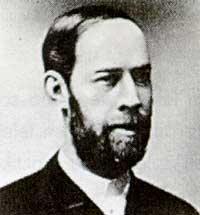Hertz, Heinrich
(1857-1894)
This German physicist entered the world of Hamburg on 22 February 1857. As a young man he began to study engineering, but he abandoned these studies and began to study physics. Herman von Helmotz was a professor and especially a friend throughout his life.
He finished his doctorate in physics at the University of Berlin in 1880, obtaining the qualification of "magna cum laude". From 1885 to 1889 he was professor of physics at the Karlsruhe Polytechnic School and from 1889 professor at the University of Bonn at the post given by Clausius.

Working at the University of Kiel in 1883, he took care of the equation that Maxwell recently obtained for the electromagnetic field. The Berlin Academy of Sciences announced a prize for his magnetic field work and Helmotz proposed to his student to work in this field. Hertz began his work in 1888 without much encouragement, but in 1888 he found something unexpected. Two metal spheres separated by air had prepared an oscillating electric circuit. When the difference in potential exceeded one level in one direction or another, the spark went from one sphere to another. In these trials he discovered that when in the negative pole there was ultraviolet light the spark jumped more easily. These were the beginnings of the photoelectric effect, which Einstein then served to study the phenomenon and win the Nobel Prize.
Maxwell's equation stated that in the oscillating spark electromagnetic radiations could be produced. Each oscillation should produce a wave, with a radiation of great wavelength. As the light propagates at a speed of 300,000 km/h, the oscillation of the thousandth second would have an approximate wavelength of 300 kilometers.
To detect this radiation, Hertz used a rolled wire, leaving a small air space between the coils. When the current generated radiation in the first spire, it would provoke a current in the second. Hertz saw small sparks jump in his detector. Placing the detector at different points in the room, he analyzed the characteristics of the waves according to the intensity of the spark and calculated its wavelength. They were 66 centimeters, that is, a million times longer wave than that of visible light. He also showed that these waves were electromagnetic.
In England Lodge checked the trials of Hertz and in Italy demonstrated Righi's relationship with light waves. Then, when Marconi used the hertz waves in the wireless telegraphy, they called them radiowaves (the radio is, in fact, the abbreviation of the "radiotelegraphy", that is, the telegraph by radiation, very different to the telegraph by electric current).
Hertz studied cathodic rays at the University of Bonn. These rays seemed to him no corpus and waves, as they crossed very thin metal plates. Then Thomson proved that the electron is a much smaller particle than the atom and can easily cross the matter.
Hertz also wrote several books on physics, including Electric Waves 11893 and Fundamentals of Mechanics (1899). He also explained the behavior of dielectrics in induction.
Hertz dies young (before the age of thirty-seven) a chronic disease in medium blood. His death led him to Bonn on January 2, 1894.
Buletina
Bidali zure helbide elektronikoa eta jaso asteroko buletina zure sarrera-ontzian











